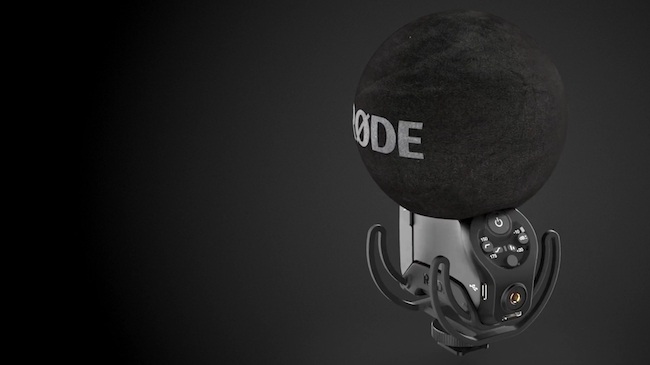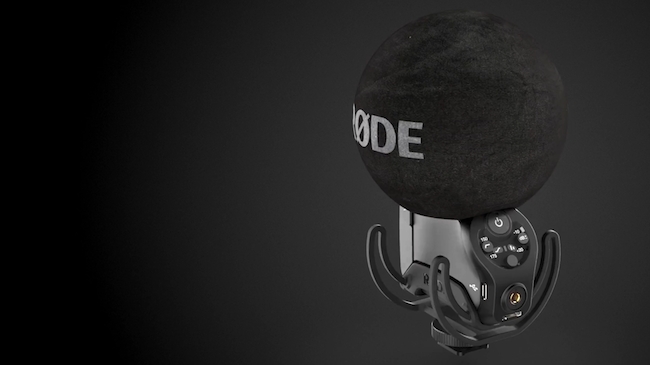
 The new Videomic Soundfield rotates into view...
The new Videomic Soundfield rotates into view...
Technically it was Røde owner Freedman Electronics celebrating its big five oh, but in launching five new mics, including the first ambisonic unit badged under new acquisition Soundfield, it managed to spread the celebratory mood a bit further than usual.
Some companies attend trade shows. Others send out mailshots to interested journalists. Røde does those things, but they've also just released a half-hour video presentation which covers five upcoming mics for both studio and field use, including one which deals with three-dimensional audio. It's small enough to sit on a DSLR and will be of much interest to people shooting 360-degree material. We'll save that for last though, as the company did, and first have a quick look at the new studio mics.
The company seems to be leaning heavily toward the classic sound of valve (vacuum tube as it is known in America) technology in its capsule and ribbon microphones. The new TFM-50 is such a design and incorporates a spherical housing around the large capsule which is intended to make the microphone more suitable for use in situations such as orchestral recordings, where it may be suspended some distance overhead. The idea is for the housing to provide for slightly improved directionality in high frequencies, to offset the distance-related losses. Naturally this is a rather interpretive thing, but it provides another option to people who need to balance the potentially-desirable ambience of an auditorium against the sound of the orchestra.
The second piece of engineering news involves a new capsule for the NT1, which is itself a microphone so widely used that it's well-known, even among people who have little contact with studio audio recording. The capsule previously used was designated HF6 by the company, and is, logically, to be supplanted by the HF7, which is designed to be used in various of the company's products. Similar valve circuitry is included and the pickup pattern is variable, including both cardioid and figure-eight arrangements, controllable from the connected power supply.
To finish up in the studio, we find a product based on the ribbon technology Røde launched in 2015. The NT-RV is to combine that technology with the new valve-based electronics.
Røde in the field
Moving on to subjects more directly relatable to film and television work, and particularly field production, the company has announced a revision to its NT-5 condenser. It's been referred to as a pencil mic, built rather like a shotgun but without the long front end. The NT-5 has been used both in the studio on instruments such as guitar, and in the field, where it can be combined (in a matched pair, which Røde will supply) for stereo recording in any of the common modes. Røde makes a mounting bar which will support the mics in XY, ORTF or spaced pair format, and informs us that recent revisions to the NT-5 involve a new capsule manufacturing technique.
Røde jumped on the video bandwagon in 2004, which must now, in retrospect, seem like a practically precognitive bit of thinking as it allowed the company to deftly catch the explosion of what we might call the lightweight video sector. The diminutive Video Mic Pro, released in 2010, and then updated in 2015 with a Rycote-style shock mount, is now to be revised again as the Video Mic Pro+. Yes, Pro Plus, no relation to the anti-fatigue remedy.
The specification is really quite impressive. There are high-pass filters at 75 and 100Hz, as well as an HF shelf, which are implemented digitally and therefore very configurable. Something other companies should take note of is Røde's decision to use a threader, locking 3.5mm jack connector (used in TRS format) for the signal output.
Perhaps the most significant update is in the power handling. The new version runs on either AA cells or Røde's own custom rechargeable battery pack, which they claim provides 100 hours of runtime and can be recharged in less than two hours in the mic when USB power is available. The whole mic can also be run from USB power, and there's a feature which detects plug-in power on the 3-pole jack and uses that to activate and deactivate the mic, the better to avoid inadvertently leaving the power on when it should be off, or, perhaps worse, off when it should be on. This is an extremely comprehensive provision and suggests that the company enjoys an excellent understanding of its market and the world of DSLR filmmaking in general.
Early fruits of the Soundfield purchase
The biggest Røde news in early 2017, however, is their acquisition of Soundfield, a company specialising in ambisonics. This three-dimensional sound technique dates from British research of the 1970s and is one we mentioned in passing with regard to Sennheiser's showing at IBC last year. Soundfield has so far been known mainly in the world of outside broadcast, where their designs have been used to capture ambient sound in 5.1 surround for live sports events. The fruits of Røde's purchase, however, are soon to find further expression in something smaller.
It looks disarmingly like the conventional Video Mic Pro+, but actually the Videomic Soundfield includes four capsules in a tetrahedral pattern. From this array, via appropriate signal processing, mono, stereo, 5.1 surround or even surround formats involving overhead and underfloor speakers can be derived. Of particular use to videographers is the ability to select a pattern of sensitivity, including stereo and mono virtual microphones, which will be created using the information available from the four capsules.
It's possible that there will be compromises should a user decide to buy this microphone and treat it mainly as a simple on-camera mic, and the ambisonics mic is at least likely to be more expensive than a conventional Video Mic Pro+. In an ideal world, though, it might stand to do double duty on both conventional and surround sound jobs as the need arises. Post production and distribution technologies for spherical soundfields as picture-synchronised audio are likely to remain limited to processing it down into 5.1 surround sound, at least for the foreseeable future, although the growth of VR might soon raise new uses for it.
And, seeing as how the company went to such trouble to announce these mics in a half hour video, you can watch it below.
Tags: Audio


Comments